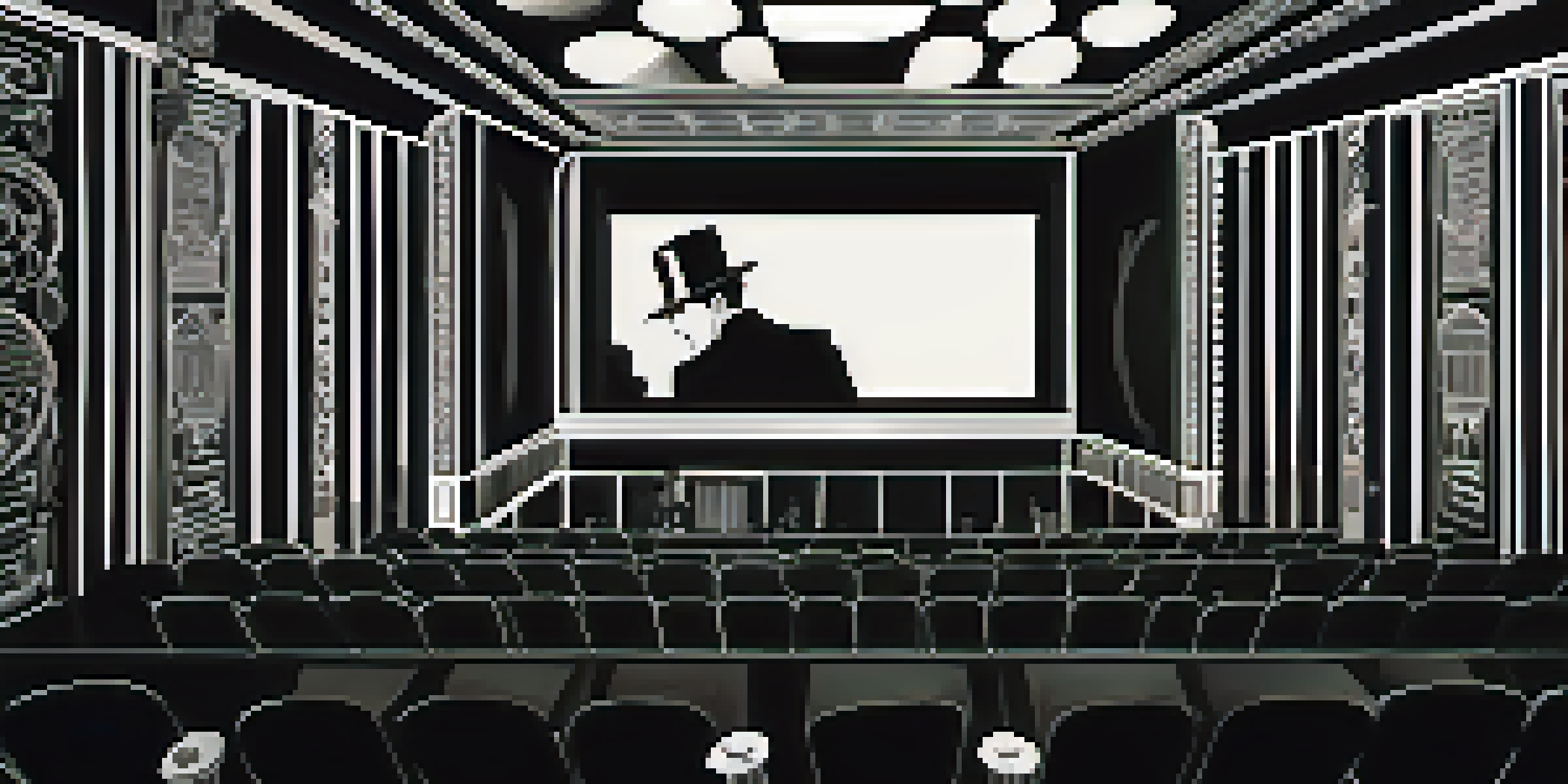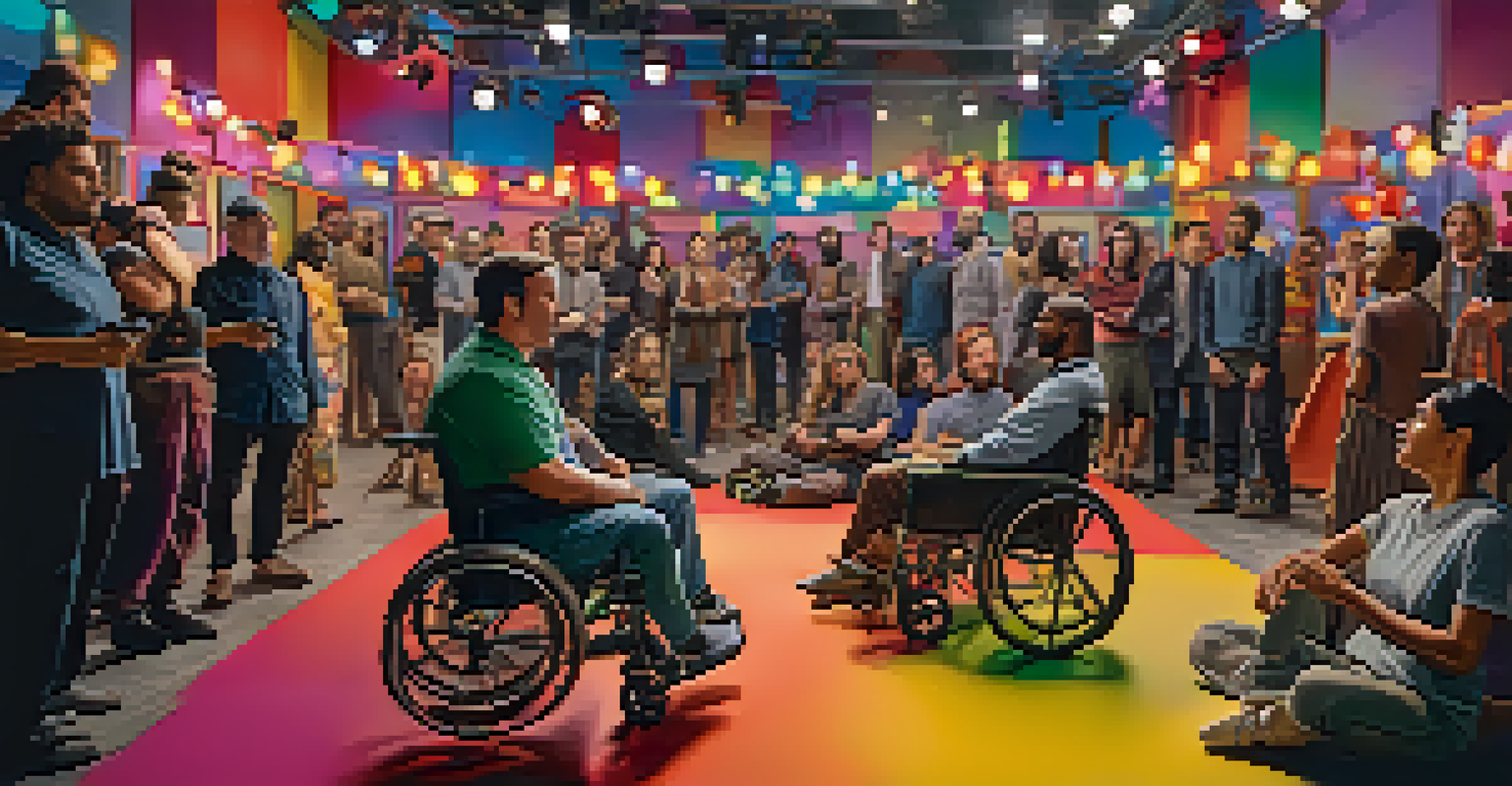Hollywood’s Portrayal of Disability: A Historical Perspective

Early Cinema: Stereotypes and Marginalization
In the early days of cinema, disabilities were often depicted through a narrow lens, reinforcing stereotypes and marginalization. Characters with disabilities were frequently portrayed as villains or tragic figures, which perpetuated societal fears and misunderstandings. For instance, silent films often used physical deformities to signal moral failings or otherness, reducing complex human experiences to mere caricatures.
The greatest tragedy in life is not death, but a life without purpose.
This pattern not only alienated individuals with disabilities but also limited audiences' understanding of their realities. With few positive representations, the public's perception was shaped largely by exaggerated and negative portrayals. The lack of authentic voices in storytelling meant that these depictions rarely reflected the true diversity and richness of disabled lives.
As audiences began to demand more authenticity, the film industry faced pressure to rethink its approach to disability. This marked the start of a gradual shift that would take decades, as filmmakers began to explore more complex narratives surrounding disability.
The 1930s to 1950s: The Rise of the 'Inspiration' Narrative
During the 1930s to 1950s, Hollywood saw a surge in films that presented characters with disabilities as sources of inspiration for able-bodied individuals. These 'inspiration' narratives often depicted disabled characters overcoming their challenges to achieve extraordinary feats, creating a sense of admiration among viewers. However, this often simplified the realities of living with a disability and painted an unrealistic picture of resilience.

Movies like 'The Miracle Worker' showcased the triumph of individuals with disabilities, but they also risked overlooking the everyday struggles faced by disabled people. While these films aimed to evoke empathy, they inadvertently reinforced the notion that a disability could only be seen as positive when it was overcome in dramatic fashion.
Stereotypes in Early Cinema
Early films often portrayed characters with disabilities through negative stereotypes, limiting public understanding and reinforcing societal fears.
This period set the stage for future portrayals, as filmmakers began to recognize the potential of disability to drive meaningful stories. However, the focus on inspiration often overshadowed the nuances of living with a disability, leaving a gap in authentic representation.
The Counterculture Movement: Challenging Norms
The 1960s and 1970s marked a significant shift as the counterculture movement began to challenge societal norms, including attitudes towards disability. Activists fought for rights, accessibility, and representation, and their efforts started to resonate within Hollywood. Films began to feature more diverse characters, and the perspective around disability started to broaden.
Inclusion is not a matter of political correctness. It is the key to growth.
This era saw the emergence of films that presented disabled characters in more relatable and multifaceted ways. Movies like 'One Flew Over the Cuckoo's Nest' depicted the struggles of individuals within the mental health system, showcasing not just their disabilities but also their humanity and desires. Such films helped to humanize the experiences of disabled individuals and prompted audiences to reconsider preconceived notions.
However, while progress was made, Hollywood still struggled with consistent representation. The challenge remained to balance authentic storytelling with the commercial pressures of mainstream cinema.
The 1980s and 1990s: Acknowledgment and Misrepresentation
The 1980s and 1990s brought both acknowledgment and misrepresentation of disability in Hollywood. On one hand, films began to feature characters with disabilities more prominently, offering a wider range of stories. On the other hand, many portrayals were still steeped in stereotypes, with able-bodied actors often playing disabled roles, a practice that sparked significant debate.
Movies like 'Rain Man' introduced audiences to autism, yet they also risked oversimplifying complex conditions into digestible narratives. This led to conversations about authenticity in casting and the necessity of disabled actors in portraying their own experiences. The backlash against misrepresentation intensified, pushing for a more inclusive approach within the industry.
Shift to Authentic Representation
The film industry is gradually evolving to include more authentic narratives and diverse voices, reflecting the complexities of living with disabilities.
This era highlighted the importance of representation behind the camera as well, with calls for disabled writers and directors to tell their own stories authentically. The demand for change began to shape the landscape, setting the stage for future developments.
The 2000s: Diversity and the Rise of Authentic Voices
Entering the 2000s, the conversation around disability representation evolved significantly. Filmmakers started to prioritize authentic voices, leading to a more diverse range of stories about disability. As a result, audiences were introduced to characters that were not merely defined by their disabilities but were complex individuals with hopes, dreams, and flaws.
Films like 'A Beautiful Mind' and 'The Intouchables' garnered critical acclaim, showcasing the intricacies of living with mental health challenges and physical disabilities. These stories resonated with audiences, revealing the potential for cinema to foster understanding and empathy. However, there remained a need for more stories that reflected the true diversity within the disability community.
As the demand for authenticity grew, the industry began to recognize the talents of disabled actors, writers, and directors. This shift not only enriched storytelling but also opened doors for a new generation of filmmakers who could bring their lived experiences to the forefront.
Recent Trends: Nuanced Representation and Intersectionality
In recent years, Hollywood has made strides toward more nuanced representations of disability, embracing intersectionality and the complexities of identity. Filmmakers are increasingly focused on telling stories that reflect the diverse experiences of disabled individuals across different backgrounds and cultures. This shift is significant, as it recognizes that disability intersects with race, gender, sexuality, and other social identities.
Shows like 'Crip Camp' and films like 'Sound of Metal' have garnered praise for their authentic portrayals and for featuring disabled talent both in front of and behind the camera. These narratives challenge stereotypes and invite audiences to engage with disability in a more compassionate and informed manner. They highlight the importance of storytelling that resonates with real-life experiences rather than relying on tropes.
Future of Inclusive Storytelling
The future of disability representation in Hollywood depends on the commitment to authentic storytelling and inclusive practices behind the camera.
By embracing these complexities, Hollywood has the potential to foster a deeper understanding of disability, ultimately helping to dismantle long-held prejudices. The ongoing evolution reflects not just a change in representation but also a growing recognition of the richness and diversity of disabled lives.
The Future: Towards Authentic and Inclusive Storytelling
Looking to the future, the journey of disability representation in Hollywood is far from over. As audiences continue to demand greater authenticity and inclusivity, filmmakers are challenged to rise to the occasion. This means not just casting disabled actors but also creating stories that reflect the realities of living with disabilities in a meaningful way.
The emphasis on representation behind the camera remains crucial, as diverse voices shape the narratives being told. The inclusion of disabled writers, directors, and producers can lead to more authentic storytelling, ensuring that the experiences of disabled individuals are accurately represented. Moreover, as technology advances, new platforms and formats can offer innovative ways to share these stories.

Ultimately, the future of disability representation in Hollywood hinges on a commitment to understanding, empathy, and inclusivity. By prioritizing authentic narratives, the industry can contribute to a cultural shift that recognizes the value and richness of all human experiences, including those of people with disabilities.